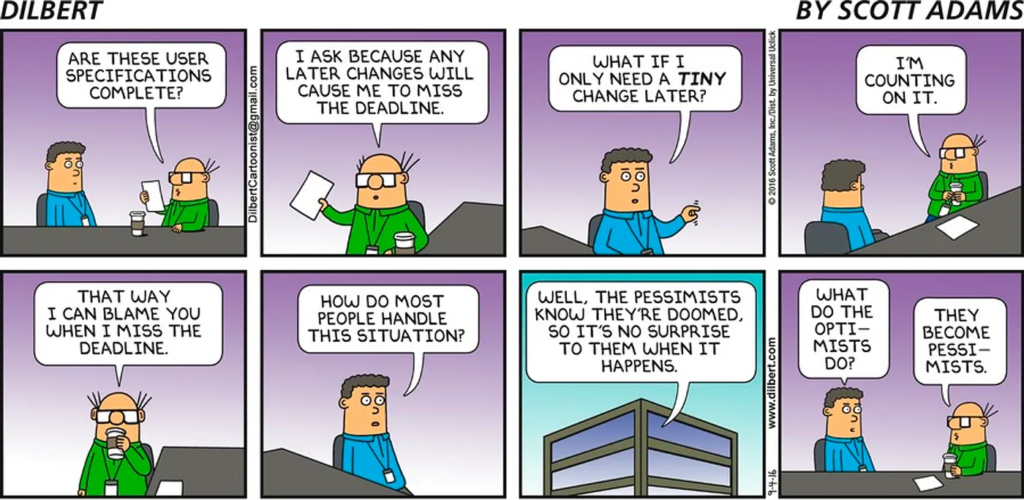Have you ever found yourself in one of these team retrospectives, where everyone is trying to figure out why everything went wrong?
You’ve missed your iteration goal for the second time in a row, with last-minute changes, unstable releases, and ad-hoc requests piling up. Frustration and confusion start spreading all over the room.
If you’re an engineer, you’ve been through this more than once and would be all too familiar with how much the role of your product manager shaped the team’s efficiency and morale when times were tough. Over the past nine years, I’ve been working almost every day with product managers and owners on products meant to make people’s lives easier. As an engineer,
I always find it challenging for product managers to keep a balance between managing technology and managing people. I’ve witnessed a lot of missed opportunities for teams to produce timely and quality outcomes and results for the products they worked on, although these teams had plenty of great talents with solid experience under their belts.
So how can you do better as a product manager to unleash the full potential of your team?
Here are 10 winning characteristics the best product managers have in common.
1. They make themselves available to their teams.
Most of us had the chance to work with those product managers who were so busy that they rarely came to our stand-ups, didn’t reply to Slack threads, and never attended retrospective meetings. They prepare just enough for other scrum events like pre-planning, backlog refinement, and sprint planning meetings, and that’s fine. The problem is that in many cases,
it is necessary to have a responsive product manager who can give the team answers and guidance as needed during the sprint. We never assume that within two to three weeks, we’ll have a well-defined scope with clear acceptance criteria. The best product managers always make time to participate in ad-hoc calls or to respond to a thread in which the front-end and back-end engineers argue about something.
2. They ask the right “Why?” questions and bring solid problem statements to the team.
Product and engineering teams may find themselves frequently asking, “What do we need to build next?” as they have numerous boards piled high with features and requirements waiting to be picked. However, product excellence is not determined by the quantity of items delivered; it is determined by the value these items add to consumers and other stakeholders. That’s why it is essential to take a breather every so often and switch from asking “what?” questions to “why?” questions whenever possible.
Experienced product managers never present their teams with solutions but rather with problem statements. For instance, instead of being asked to implement a user provisioning feature using CSV sheets, the team working on the B2B product should instead hear about the problems that the users are having when it comes to onboarding new corporate customers. Clear problem statements let the team use their creativity,
product knowledge, analytical and critical thinking skills, and other skills to solve problems and come up with good ideas. Delivering features alone won’t solve issues; providing value will. Because of this, it is a product manager’s responsibility to conduct appropriate discovery and requirement gathering to enhance the conversations they have with their teams. That should lead to a list of possible solutions that can be put into action to solve the problem that was already mentioned.

3. They don’t turn their products and teams into “feature factories”.
A “feature factory” is a product or company that measures output over outcomes. It’s a story point machine where the company only cares about how much is being shipped. The company celebrates the work done, and it feels like a conveyor belt going in one direction. No one is thinking about the question: is any of this working? No one is thinking if any of this complexity is adding business value.
Occasionally, in feature-factory teams, feedback on the deliverables is provided without the participation of the individuals who worked on them. Customers, stakeholders, and product managers all participate in the feedback loop. A good product manager will ensure that their team is kept in the loop at all times. It’s always important to make sure that engineering teams can see the organization’s goals,
the metrics used to measure how well the results are working, and the direction that each of them should be going in. Whenever they see the benefit in including the engineering teams in stakeholder discussions, they make sure to do so without overburdening them.
They keep giving feedback on what the team did, celebrate when things go well, and give the team the credit they deserve. Additionally, they are eager to discuss concerns and errors the team has made to improve in the future.
4. Product managers can deal with unplanned work problems.
No matter how well a team plans its activities, there are always going to be some surprises popping up in the middle of the sprint, and the product manager and the team need to find an efficient way to deal with them. Unplanned work comes in many forms, such as emergency production bugs, data corruption, a small change in a requirement that stops us from launching a new feature, or an angry customer or stakeholder that we need to do our best to keep.
As you can see, there are countless possibilities, and the product manager is the team’s first line of defense. He or she should be able to effectively communicate the issue, put a plan in place, and do so cautiously to make sure that the team’s focus and morale won’t be affected.

5. They enjoy getting into technical discussions with their teams.
Being a technical expert with hands-on experience is not a skill needed for product management. The ability to read between the lines, take in the information at hand, and lead productive conversations with engineering teams is, however, indispensable. Without it, it would be hard for product managers to figure out why the team needs two sprints to show or hide buttons on a screen that has been there for four years and hasn’t been touched since then.
Product managers must work to gain a thorough understanding of the system architecture, how each component interacts with other services, and the technologies and tools the team is using. By doing this, they will have a better chance of getting involved in the team’s technical threads and knowing what system limits they need to work on or avoid until they deal with the team’s technical debt.
Understanding various software development processes and terminologies is essential, even if you don’t have hands-on experience with their application. A good product manager is aware of the team’s process for releasing new features, how production bugs are fixed, and what the evil term “CI/CD” is all about.
6. They can weather stakeholders’ storms and protect their teams.
There are a lot of ways to define the word “stakeholder.” From my point of view, a stakeholder is someone interested in the product in some way. This could be a customer, a shareholder, someone who has a say in the product’s direction and strategy, or anyone who will be affected directly or indirectly by changes to the product. Based on this definition, managing stakeholders has always been seen as one of the hardest jobs anyone could have, and product managers can’t avoid doing it.
Stakeholders will always want to have the features they ask for as soon as possible. This is where a product manager’s skills come into play. It is essential to provide the engineering team with a sufficient amount of time to discuss requirements and evaluate feasibility. After that, it is the responsibility of the product manager to vouch for the team’s decisions and estimated delivery timelines. Most of the time, product managers are dragged into conversations where they have to commit to a timeline. If they do this without making sure their teams are on the same page, it could lead to unnecessary pressure, a lot of context switching, and a lower level of quality in the result.

7. They are data-oriented people who speak the right numbers.
When it comes to numbers, we’re talking about the right ones, because if we measure the wrong things, it’ll only make the situation worse over time.
I’ve known product managers who gauged product success based on the number of contracts won and the number of new features released each quarter. These numbers are ineffective because they indicate nothing other than a lack of product vision. Better metrics and measures should pay attention to aspects like customer retention and acquisition rates, user satisfaction and reported complaints or crashes, the impact of delivered features, etc.
It is always difficult to convince a competent engineering team that ask the right questions about features or requirements that are supported by nothing but a product manager’s sense of urgency. The team should have the freedom to contest the necessity of a feature, asking for the impact in numbers and supporting data. The product manager should be ready for these talks and have put in the time and effort to gather these numbers and data for their teams, not to mention the market and user research that should have been done before this step.
8. They create well-written documents that explain almost everything.
The ability to create excellent documentation is one of the abilities I’ve observed in every reliable product manager I’ve worked with. How well a product manager can communicate concepts, problem statements, product vision, and a variety of other things to the rest of their team will largely determine how effective they are. It’s helpful to be able to articulate ideas and document them so they can be shared with engineers, sales reps, business stakeholders, etc.
These documents could save a ton of time and effort in explaining a product and instead give the readers the chance to absorb the information and work on it asynchronously, which is more efficient, especially for engineering teams. Everyone should always look to well-written user stories and PRDs (Product Requirements Documents) as their source of truth, not just the engineering team that is working on the implementation of the feature.

9. They contribute to the growth of more product-minded, autonomous engineers.
Not every problem that a product manager brings up needs a technical solution. No matter how technical the ideas or solutions are, a team’s level of excellence is always determined by how well they can come up with good ideas and solve problems. Team members should be able to challenge problems and modify the existing system to meet requirements with minimal technical modifications. Not only should they lead the “How?” phase, but they can also suggest changes to the scope that would result in greater value. Smart product managers allow their teams to participate in all phases and do not just see them as executors who arrive late to the product evolution phases.
Additionally, confident product managers give the team the room and degree of autonomy required to make tactical decisions and manageable scope changes that benefit them but don’t detract from the project’s overall deliverables. By doing this, the product manager won’t become a bottleneck who needs to be consulted on even the smallest changes.
10. They create solid GTM plans for product releases.
A go-to-market plan, also known as a GTM plan, is an important step to guarantee that the users you have in mind will be aware of the launch of a new product or feature. This plan should cover a wide range of topics, including who will use this feature, how they will be notified, and what the expected outcomes are. It should also contain a clear set of action items with their respective owners.
The team needs to be aware of what is expected of them during the development, release, and launch phases, so this plan needs to be open to changes as they go forward and visible to all stakeholders. This gives them confidence that they’re working to a plan and won’t be surprised by unplanned tasks like user provisioning or technical support.

Final Thoughts
It always takes time to build a strong team that performs well and whose members are confident in each other’s judgment and decisions. Product managers should receive the utmost support because they are the ones who carry the flame and light the way for their engineers. In addition, it is their responsibility to ensure that the team is focusing its efforts on activities that are beneficial to them and the organization as a whole.
Article written by Muhammad Hani, Thndr’s Head of Engineering, who is passionate about building products that matter.




